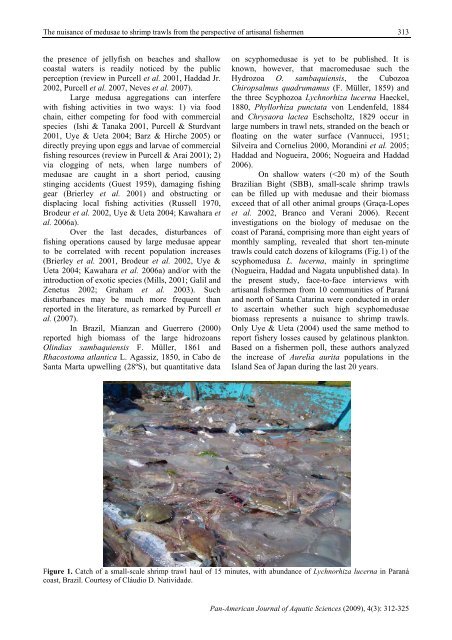Download full issue - PanamJAS
Download full issue - PanamJAS
Download full issue - PanamJAS
Create successful ePaper yourself
Turn your PDF publications into a flip-book with our unique Google optimized e-Paper software.
The nuisance of medusae to shrimp trawls from the perspective of artisanal fishermen<br />
313<br />
the presence of jellyfish on beaches and shallow<br />
coastal waters is readily noticed by the public<br />
perception (review in Purcell et al. 2001, Haddad Jr.<br />
2002, Purcell et al. 2007, Neves et al. 2007).<br />
Large medusa aggregations can interfere<br />
with fishing activities in two ways: 1) via food<br />
chain, either competing for food with commercial<br />
species (Ishi & Tanaka 2001, Purcell & Sturdvant<br />
2001, Uye & Ueta 2004; Barz & Hirche 2005) or<br />
directly preying upon eggs and larvae of commercial<br />
fishing resources (review in Purcell & Arai 2001); 2)<br />
via clogging of nets, when large numbers of<br />
medusae are caught in a short period, causing<br />
stinging accidents (Guest 1959), damaging fishing<br />
gear (Brierley et al. 2001) and obstructing or<br />
displacing local fishing activities (Russell 1970,<br />
Brodeur et al. 2002, Uye & Ueta 2004; Kawahara et<br />
al. 2006a).<br />
Over the last decades, disturbances of<br />
fishing operations caused by large medusae appear<br />
to be correlated with recent population increases<br />
(Brierley et al. 2001, Brodeur et al. 2002, Uye &<br />
Ueta 2004; Kawahara et al. 2006a) and/or with the<br />
introduction of exotic species (Mills, 2001; Galil and<br />
Zenetus 2002; Graham et al. 2003). Such<br />
disturbances may be much more frequent than<br />
reported in the literature, as remarked by Purcell et<br />
al. (2007).<br />
In Brazil, Mianzan and Guerrero (2000)<br />
reported high biomass of the large hidrozoans<br />
Olindias sambaquiensis F. Müller, 1861 and<br />
Rhacostoma atlantica L. Agassiz, 1850, in Cabo de<br />
Santa Marta upwelling (28ºS), but quantitative data<br />
on scyphomedusae is yet to be published. It is<br />
known, however, that macromedusae such the<br />
Hydrozoa O. sambaquiensis, the Cubozoa<br />
Chiropsalmus quadrumamus (F. Müller, 1859) and<br />
the three Scyphozoa Lychnorhiza lucerna Haeckel,<br />
1880, Phyllorhiza punctata von Lendenfeld, 1884<br />
and Chrysaora lactea Eschscholtz, 1829 occur in<br />
large numbers in trawl nets, stranded on the beach or<br />
floating on the water surface (Vannucci, 1951;<br />
Silveira and Cornelius 2000, Morandini et al. 2005;<br />
Haddad and Nogueira, 2006; Nogueira and Haddad<br />
2006).<br />
On shallow waters (
















